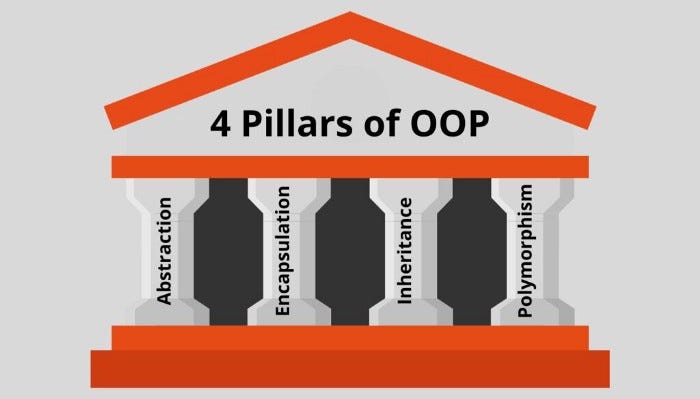The Pillars of Object-Oriented Programming (OOP) in Python
This post explores the four key pillars of Object-Oriented Programming (OOP) in Python: encapsulation, abstraction, inheritance, and polymorphism. Understanding these fundamental principles will help you write more modular, reusable, and organized Python code.
Introduction to Object-Oriented Programming
Object-Oriented Programming (OOP) is a programming paradigm based on the concept of “objects,” which are instances of classes that can hold both data (attributes) and methods (functions). OOP allows for efficient code organization and reusability.
The four pillars of OOP are:
- Encapsulation
- Abstraction
- Inheritance
- Polymorphism
Let’s dive into each one and understand how Python supports these powerful concepts.
Encapsulation
Encapsulation refers to the bundling of data (attributes) and methods that operate on that data within one unit, or class. It hides the internal state of an object and only exposes the necessary methods, preventing direct access to the object’s internal data.
Example: Encapsulation in Python
In Python, we use underscores to indicate private and protected attributes. Single underscore (_) denotes a protected attribute, while double underscores (__) denote a private attribute.
1
2
3
4
5
6
7
8
9
10
11
12
13
14
class A():
def __init__(self):
self.__counter = 0 # Private attribute
def increment(self):
self.__counter += 1
def get_count(self):
return self.__counter
a = A()
print(a.get_count()) # Output: 0
a.increment()
print(a.get_count()) # Output: 1
In the above example, the __counter attribute is encapsulated within the class A, and can only be modified using the methods defined in the class, such as increment().
Good Practices in Encapsulation
Encapsulation helps protect the integrity of data and prevents unauthorized or unintended changes to an object’s internal state. Always use getter (@property) and setter (@attribute.setter) methods to control access to private attributes properly.
1
2
3
4
5
6
7
8
9
10
11
12
13
14
15
class A():
def __init__(self):
self._value = 0 # Protected attribute
@property
def value(self):
return self._value
@value.setter
def value(self, new_value):
self._value = new_value
a = A()
a.value = 10 # Set new value using setter
print(a.value) # Get value using getter - Output: 10
This is an example of best practices for encapsulating class properties and safely interacting with them.
Abstraction
Abstraction is the process of hiding complex implementation details and exposing only what is necessary. It simplifies interaction by providing a clean interface.
Example: Using @property to Abstract Data
The use of decorators like @property is an effective way to abstract access to data. Instead of directly accessing an attribute, you provide a clean, readable way to get and set values.
1
2
3
4
5
6
7
8
9
10
11
12
13
14
15
16
17
18
19
class A():
def __init__(self):
self._count = 0
@property
def count(self):
return self._count
@count.setter
def count(self, value):
if value >= 0:
self._count = value
else:
print("Invalid value. Count must be non-negative.")
a = A()
a.count = 5 # Set using setter
print(a.count) # Get using getter - Output: 5
a.count = -3 # Output: Invalid value. Count must be non-negative.
By providing these getters and setters, the actual attribute is protected, and we control how it is accessed and modified.
Inheritance
Inheritance allows a class (child class) to inherit attributes and methods from another class (parent class). This helps in code reusability and establishing a natural hierarchical relationship between classes.
Example: Inheritance in Python
1
2
3
4
5
6
7
8
9
10
class Animal:
def speak(self):
print("The animal makes a sound")
class Dog(Animal):
def __init__(self, name):
self.name = name
my_dog = Dog("Max")
my_dog.speak() # Output: The animal makes a sound
Here, Dog inherits the speak() method from the Animal class, demonstrating the reusability of code.
Using super()
The super() function is used to call a parent class’s constructor or methods. This is especially useful when you need to extend the functionality of a parent class.
1
2
3
4
5
6
7
8
9
10
11
12
class Animal:
def __init__(self, name):
self.name = name
class Dog(Animal):
def __init__(self, name, sound):
super().__init__(name) # Call the parent class constructor
self.sound = sound
my_dog = Dog("Max", "Woof Woof")
print(my_dog.name) # Output: Max
print(my_dog.sound) # Output: Woof Woof
Polymorphism
Polymorphism allows different classes to define methods with the same name but potentially different behaviors. This makes the code more flexible and extensible.
Example: Polymorphism in Python
1
2
3
4
5
6
7
8
9
10
11
12
13
14
15
16
17
18
19
class Animal:
def speak(self):
print("Some sound")
class Dog(Animal):
def speak(self):
print("Woof Woof")
class Cat(Animal):
def speak(self):
print("Meow Meow")
def make_animal_speak(animal):
animal.speak()
my_dog = Dog()
my_cat = Cat()
make_animal_speak(my_dog) # Output: Woof Woof
make_animal_speak(my_cat) # Output: Meow Meow
Here, both Dog and Cat classes have a speak() method, but each implements it differently. The function make_animal_speak() works with any object that has a speak() method, demonstrating polymorphism.
Practice Exercises
Exercise 1: Encapsulation Practice
Create a class Student with private attributes for name and grade. Provide public methods to set and get these attributes, ensuring that grades are always non-negative.
Exercise 2: Inheritance Practice
Create a Vehicle class with attributes like make and model, and derive Car and Motorcycle classes from it. Each subclass should have its unique method that prints specific information about the vehicle.
Exercise 3: Polymorphism Practice
Create classes Bird and Fish with a method move(). Implement move() to represent how each animal moves. Write a function that takes an object and calls move() to demonstrate polymorphism.
More Information
Understanding the four pillars of OOP—encapsulation, abstraction, inheritance, and polymorphism—will help you build robust, modular, and reusable code. Applying these principles effectively is key to mastering Python’s OOP capabilities.
For more learning, check out:
Next Steps: In the next post, we will explore POO Classes, Attributes, Methods, including classes, objects, and inheritance. Stay tuned and keep coding!
